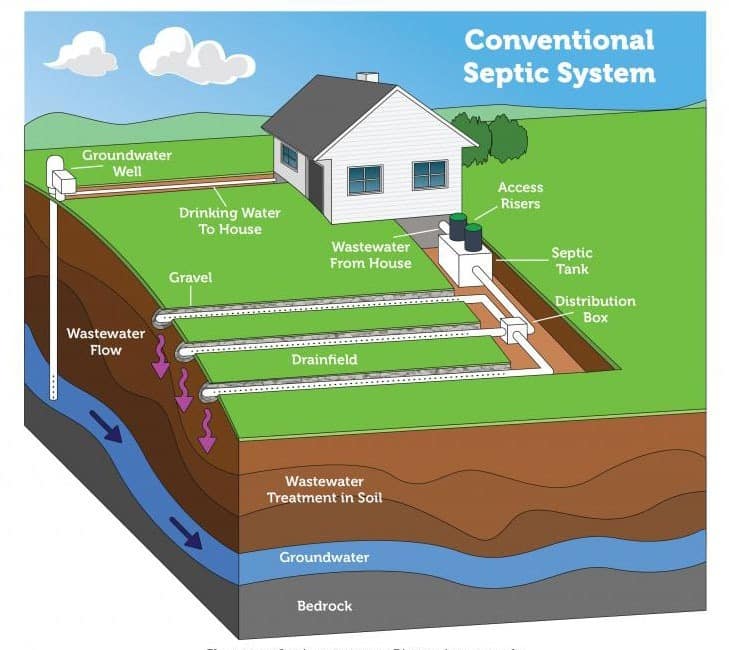Living in a flood zone can be both beautiful and nerve-wracking. While the picturesque views may be worth it, the risk of flooding is always present. And when it comes to protecting your home, there’s more to consider than just keeping your belongings dry. If you have a septic tank, you need to take extra precautions to ensure that it doesn’t flood.
In this article, we’ll explore the risks of septic tank flooding and provide you with practical tips for protecting your system during floods. We’ll also discuss common mistakes to avoid and emphasize the importance of regular inspections. By the end of this article, you’ll have a better understanding of how to prepare for and manage septic tank maintenance in flood zones.
Understanding Your Septic Tank
Before you can protect your septic tank in a flood zone, it’s important to understand how it works. A septic tank is an underground container that holds household wastewater long enough for solids to settle and for the liquids to flow out into the drainage field. The solids that settle at the bottom of the tank are broken down by bacteria and eventually pumped out by a professional. The liquid that flows out into the drainage field undergoes further treatment in the soil before returning to groundwater.
The size of your septic tank is determined by factors such as the number of people living in your home, water usage habits, and soil conditions on your property. It’s important to know where your septic tank is located and how to access it for regular maintenance or pumping.
In addition, understanding what should not go down your drains and toilets can help prevent expensive repairs later on. Avoid flushing non-degradable items such as feminine hygiene products, dental floss, cigarette butts, or grease down sinks or toilets as they can clog pipes leading to your septic system. Knowing how often you should have maintenance conducted will also prolong life of system.
The Risks of Septic Tank Flooding
Flooding can cause significant damage to your septic tank system. When your septic tank floods, it can lead to a range of issues such as contamination of your water supply, health hazards, and costly repairs. Understanding the risks associated with septic tank flooding is crucial in managing your system and protecting your home.
Contamination of Water Supply
One major risk associated with septic tank flooding is the potential contamination of your water supply. When floodwater enters your septic tank system, it can overflow into nearby wells or drains, causing harmful bacteria to infiltrate your drinking water. This poses a serious health hazard for you and your family and requires immediate action.
In addition to potentially contaminating your drinking water, flooding also puts a strain on the overall effectiveness of the septic system. The excess water can force solid waste out of the tank and into the drainfield or clog soil pores, leading to an ineffective drainfield that requires costly repairs.
Health Hazards
Another risk associated with septic tank flooding is potential health hazards. The standing water caused by floods provides an ideal environment for bacteria and viruses to grow rapidly. Exposure to contaminated floodwater can cause gastrointestinal illnesses such as diarrhea or vomiting.
In addition, flooded areas may also provide ideal breeding grounds for mosquitoes that carry diseases like West Nile Virus or Dengue Fever – making it critical that you take steps towards mitigating these risks.
Costly Repairs
If a septic tank system is not adequately protected during floods, it may require costly repairs or even replacement in extreme cases. The cost of replacing an entire septic system can be tens of thousands of dollars – something that no homeowner wants to face.
In addition to the direct costs of repairing or replacing a septic system, the indirect costs can add up quickly. For example, if you need to replace your septic system because of flooding, you may need to pay for alternative housing while the repairs are being made. The overall impact of flood damage on your property can be devastating- both financially and emotionally.
Preparing Your Septic Tank for a Flood
Elevating Your Septic Tank
One of the best ways to prepare your septic tank for a flood is to elevate it. This can be done by raising the tank itself or building up the ground around it. Raising your septic tank can help prevent water from entering and damaging it during a flood. To determine how high you need to elevate your tank, check with local codes and regulations or consult with a professional.
If you choose to raise the ground around your septic tank, make sure to use soil that is appropriate for drainage and compact it well. It’s important not to cover any access points or vents on your septic system. Keep in mind that elevating your septic tank will likely require special equipment, so consider hiring a professional.
Securing Your Septic System
In addition to elevating your septic tank, it’s important to secure all other parts of your septic system before a flood occurs. This includes securing any pipes, valves, and covers to ensure they don’t become dislodged during flooding. Check that any electrical components are raised above the expected flood level as well.
You can also install backflow prevention devices on your plumbing fixtures and drains. These devices can help prevent sewage backups in the event of a flooded sewer system.
Managing Landscaping Around Your Septic System
The landscaping around your septic system can play an important role in protecting it during a flood. Make sure that trees, shrubs, and other vegetation near your septic system are trimmed regularly so they don’t interfere with its operation.
Avoid planting anything with deep roots near your drain field as these roots may penetrate the drain lines and cause damage. Additionally, avoid parking vehicles or heavy equipment over your septic system as this can compact the soil and damage the drain field.
By taking these steps to prepare your septic tank for a flood, you can minimize the risk of damage and ensure that your system continues to function properly even in extreme weather conditions.
Rebuilding Your Septic Tank After a Flood
Assessing the Damage
After a flood, it’s important to assess the damage to your septic tank before you begin any repairs or renovations. This will allow you to determine what kind of work needs to be done and how extensive the damage is. In some cases, you may need to completely replace your septic system if there was significant damage during the flood. Start by inspecting your tank and drain field for signs of damage such as cracks or erosion.
If your tank is still relatively intact but there are damages, consider hiring a professional septic contractor who can help you assess the extent of the damages. They can also give you recommendations for repair, replacement or upgrading options based on local regulations and building codes.
It’s important not to rush into rebuilding your septic system after a flood because it needs proper planning and evaluation before beginning any repairs.
Clean Up & Repair
The first step in rebuilding your septic tank after a flood is removing all damaged materials such as sludge, debris and silt from inside it. You’ll also need to clean up any contaminated areas around it like soil or grass so that they don’t become sources of harmful bacteria later on.
If there are damages that require repairs such as cracked pipes or damaged tanks walls, hire professionals with expertise in repairing or replacing septic systems. By doing so ensures repairs are done correctly and meets safety standards while preventing future problems from reoccurring post-repair.
In addition, be sure to make any necessary upgrades – like installing new filtration systems – which can prevent future issues with flooding by ensuring that wastewater is properly filtered before being discharged into nearby waterways.
Maintaining Your Septic System Post-Flood
After rebuilding your septic system, it’s important to establish a maintenance schedule that will help prevent future problems. Regular septic tank pump outs and inspections can help keep your system running smoothly and catch any issues before they become major problems.
Other helpful tips include avoiding parking or driving near the septic tank and drain field area, limiting water usage until the soil surrounding the drain field has had sufficient time to dry out, and avoiding planting trees or bushes in the area because their roots can damage the system over time.
By taking these steps, you’ll be able to keep your septic system healthy and functioning properly even after experiencing a flood.
Managing Septic Tank Maintenance in Flood Zones
Proper maintenance of your septic tank is essential if you live in a flood zone. Not only does regular maintenance ensure that your system is functioning reliably, but it can also help to prevent damage during times of heavy rainfall and flooding. Here are some key considerations for managing septic tank maintenance in flood zones:
1. Schedule Regular Pumping
Scheduling regular septic tank pumping is an important part of keeping your system healthy, particularly in a flood zone where heavy rain and flooding can cause backup and overflow. Depending on the size of your tank and the number of people in your household, you may need to have it pumped every 1-3 years. Be sure to schedule pumping before heavy rains or flooding if possible.
2. Test Your Soil Regularly
The soil around your septic tank plays an important role in filtering wastewater and preventing contamination of nearby water sources. In a flood zone, soil saturation can quickly become a problem during heavy rains or flooding, leading to backups and other issues with your septic system. Testing the soil around your system regularly can help you identify potential problems early on.
3. Maintain Drainage Systems
In addition to maintaining proper soil conditions, it’s also important to keep drainage systems around your septic tank clear and functional at all times. This includes keeping gutters clean, ensuring that downspouts are pointed away from the drain field, and avoiding placing anything heavy on top of drain lines or tanks.
Flooding doesn’t have to be disastrous for homeowners who live in flood zones with a properly maintained septic system. By following these tips for managing maintenance year-round, you’ll be better prepared to weather any storm that comes your way.
Common Mistakes to Avoid
While preparing your septic tank for a flood, it’s important to understand the common mistakes that homeowners make. These mistakes can lead to costly repairs and damage to your property. Here are some common mistakes you should avoid:
Not Checking Your Tank Regularly
The most significant mistake most homeowners make is ignoring their septic tank until a problem arises. You should schedule regular maintenance and inspection of your tank, especially if you live in a flood zone. Make sure you have an experienced technician who can identify any potential issues before they become major problems.
Ignoring regular checkups could lead to more severe issues such as clogging of the septic system or even contamination of the surrounding water sources. Septic tanks require an adequate water level for smooth operation; thus, it’s essential to be mindful of how much water is going into the system.
Planting Trees Near Your Septic System
If you have trees in your yard, keep them away from your septic tank and drainage field. Roots can penetrate the pipes and cause blockages leading to overflowing and backups during heavy rainfall or flooding; this could contaminate groundwater sources around you.
Trees also require large amounts of water, which means that if planted close they might absorb all moisture leaving the surrounding soil dry and possibly causing cracks in your septic tank or pipes leading to leakages.
Pouring Harmful Chemicals Down Your Drains
Avoid pouring toxic chemicals down your drains as this can cause damage in your tanks by killing off beneficial bacteria or creating hazardous conditions within the drainage field. The use of high levels of bleach on cleaning materials may seem like a great way to keep everything clean; however, it could harm both human health and the environment. It’s important to use natural cleaning products or those that are recommended by your technician.
It is important to remember that prevention is better than cure. By avoiding these common mistakes and following the recommended guidelines, you can protect your septic tank in a flood zone and avoid any potential disasters.
The Importance of Regular Inspections
When it comes to protecting your septic tank from flood damage, regular inspections are an essential part of the process. Not only do they help identify potential issues before they become major problems, but they can also save you a significant amount of money and time in the long run.
Septic tanks require routine maintenance to continue functioning correctly. As such, experts recommend that you schedule a professional inspection at least every three years. However, if you live in a flood-prone area or have experienced recent flooding on your property, it is best to have your tank inspected as soon as possible after the event for any damage or contamination.
An inspection generally involves several key steps. First, the inspector will determine the size and location of your septic system components. They will then examine each component for signs of wear and tear, leaks, corrosion or other damage that could pose risks during floods. Finally, using specialized equipment like cameras or probes, they will inspect underground pipelines and assess overall system functionality to make sure everything is working properly.
Acting Quickly in the Event of a Flood
When a flood is imminent, it’s important to take quick action to protect your septic system. Here are some steps you can take:
Turn off Electricity
The first thing you must do when flooding is likely is turn off the electricity to your septic system. This will ensure that there won’t be any electrical hazards during a flood. If you’re not sure how to turn it off, contact a professional.
Reduce Water Usage
If there’s heavy rain or flooding going on, try and reduce your household water usage as much as possible. This reduces the amount of water that goes out into the drain field and helps prevent saturation of the soil around your septic tank.
Evacuate Your Home
In extreme cases where there’s an evacuation order in effect, leave your home immediately and don’t drain anything into the septic tank until after the flood has subsided and it has been inspected by a professional.
In conclusion, acting quickly when floods occur is essential if you want to protect your septic tank from damage. Turning off electricity can prevent electrical hazards; reducing water usage prevents saturation of soil around the septic tank, while evacuating homes entirely can help avoid sewage backup problems due to flooding.
Conclusion
In conclusion, protecting your septic tank in a flood zone is crucial for the safety of your home and the environment. By understanding the risks and taking preventative measures, you can avoid costly repairs and damage to your property. Remember to always have regular inspections and act quickly in the event of a flood. With these tips, you can ensure that your septic system remains functional and reliable even in the face of natural disasters. Take comfort in knowing that by taking these necessary steps, you are doing your part to protect both yourself and the world around you.




